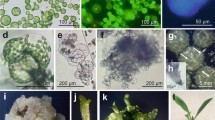Summary
The purpose of this study was to optimize growth conditions for a strain of haploid carrot callus and to follow its karyotypic changes in a long span of time. The strain has been maintained in liquid suspension since September 1977. It has remained predominantly haploid in its karyotype since that time. The original explant was initiated and subsequently subcultured in Gamborg's B5 medium. The components of the B5 medium were omitted one at a time and sequentially added back to determine their minimum, optimum, and maximum nontoxic concentrations. These changes were made in the original formula: the addition of an organic buffering agent and an increase in the iron and other micronutrient concentrations. Using this slightly modified B5 medium, we assessed the effect on growth by single additions of amino acids, different carbon sources, growth regulators, and vitamins. No improvement in plating efficiency resulted from addition of any of these compounds. We conclude that there are factors limiting the plating efficiency of the haploid cells other than these tested, or that single additions will not make a discernible difference, or that growth promoting factors cannot be exogenously supplemented to cultured cells.
Similar content being viewed by others
References
Carlson, P. S. Induction and isolation of auxotrophic mutants in somatic cell cultures ofNicotiana tabacum. Science 168: 487–489; 1970.
Sung, Z. R. Mutagenesis of cultured plant cells. Genetics 84: 51–57; 1976.
Colijn, C. M.; Kool, A. J.; Nijkamp, H. J. J. An effective chemical mutagenesis procedure forPetunia hybrida cell suspension cultures. Theor. Appl. Genet. 55: 101–106; 1979.
Redei, G. P. Induction of auxotrophic mutants in plants. Informative macromolecules in biological systems. NATO Conference. L. Ledoux, ed. New York: Plenum Press; 1974; 329–350.
Widholm, J. Cultured carrot cell mutants: 5-methyltryptophan resistant trait carried from cell to plant and back. Plant Sci. Lett. 3: 323–330; 1974.
Dudits, D.; Hadlaczky, G.; Levi, E.; Fejer, I.; Haydn, Z.; Lazar, G. Somatic hybridization ofDaucus carota andDaucus capillifolius by protoplast fusion. Theor. Appl. Gen. 51: 127–132; 1977.
Gamborg, O. L.; Miller, R. A.; Ohyama, K. Nutritional requirements of suspension cultures of soybean root cells. Exp. Cell Res. 50: 151–158; 1968.
Sung, Z. R. Turbidimetric measurement of plant cell culture growth. Plant Physiol. 57: 460–462; 1976.
Bergmann, I. A new technique for isolating and cloning single cells of higher plants. Nature 184: 648–649; 1959.
Kao, K. N. A nuclear staining method for plant protoplasts. Gamborg, O. L.; Wetter, L. R. eds. Plant tissue culture methods. Canada: National Research Council; 1975: 60–62.
Good, N. E.; Weinget, G. D.; Winter, W.; Connolly, T. N.; Izawa, S.; Singh, R. M. M. Hydrogen ion buffers for biological research. Biochemistry 5: 467–477; 1966.
Nesius, K. K.; Fletcher, J. S. Carbon dioxide and pH requirements of non-photosynthetic culture cells. Physiol. Plant 28: 259–263; 1973.
Martin, R. M.; Rose, B. Growth of plant cell (Igomea) suspension cultures at controlled pH levels. Can. J. Bot. 54: 1264–1270; 1976.
Blakely, L. M.; Steward, F. C. Growth and organized development of cultured cells. V. The growth of colonies from free cells in nutrient agar. Am. J. Bot. 51: 780–791; 1964.
Sung, Z. R.; Smith, R.; Horowitz, J. Quantitative studies of embryogenesis in normal and 5-methyl-tryptophan-resistant cell lines of wild carrot: the effects of growth regulators. Planta 147: 236–240; 1979.
Weber, G.; Lark, V. G. An efficient plating system for rapid isolation of mutants from plant cell suspensions. Theor. Appl. Genet. 55: 81–86; 1979.
Lescure, A. M. Etude quantitative de la croissance d'une culture d'Acer pseudoplatanus. Physiol. Veg. 4(4): 365–378; 1966.
Sung, Z. R.; Jacques, S. 5-fluorouracil resistance in carrot culture: its use in studying the interaction of pyrimidine and arginine pathway. Planta 148: 389–396; 1980.
Jacques, S.; sung, Z. R. Regulation of pyrimidine and arginine biosynthesis investigated by the use of phaseolotoxin and 5-fluorouracil. Plant Physiol. In press.
Sandstedt, R.; Skoog, F. Effects of amino acid components of yeast extract on the growth of tobacco tissue in vitro. Physiol. Plant. 13: 250–256; 1960.
Bennici, A.; Buiatti, M.; D'Amato, F. Nuclear conditions in haploidPelargonium in vivo andin vitro. chromosoma 24: 194–201; 1968.
Eapen, S.; Rangan, T. S.; Chadha, M. S.; Heble, M. R. Biosynthetic and cytological studies in tissue cultures and regenerated plants of haploidAtropa belladonna. Can. J. Bot. 56: 2781–2784; 1978.
Mathews, P. S.; Vasil, I. K. The dynamics of cell proliferation in haploid and diploid tissues ofNicotiana tabacum. Z. Pflanzenphysiol. 77: 222–236; 1976.
Sacristan, M. D. Karyotypic changes in callus cultures from haploid and diploid plants ofCrepis capillaris (L) Wallr. Chromosoma 33: 273–283; 1971.
Rashid, A.; Street, H. E. Growth, embryogenic potential, and stability of a haploid cell culture ofAtropa belladonna L. Plant Sci. Lett. 2: 89–94; 1974.
Furner, I. J.; King, J.; Gamborg, O. L. Plant regeneration from protoplasts isolated from a predominantly haploid suspension culture ofDatura innoxia (Mill). Plant Sci. Lett. 11: 169–176; 1978.
Hibberd, K. A.; Walter, T.; Green, C. E.; Gegenbach, B. G. Characterization of a selected feedback insensitive tissue culture line of maize. Planta 148: 183–187; 1980.
Verma, D. C.; Dougall, D. K. Influence of carbohydrates on quantitative aspects of growth and embryo formation in wild carrot suspension cultures. Plant Physiol. 59: 81–85; 1977.
Letham, D. S.; Parker, C. W.; Duke, C. C.; Sumons, R. E.; Maclead, J. K.O-glucosylzeatin and related compounds—a new group of cytokinin metabolites. Ann. Bot. 40: 261–263; 1976.
Kao, K. N.; Michayluk, M. R. Nutritional requirements for growth ofVicia hajastana cells and protoplasts at a very low population density in liquid media. Planta 126: 105–110; 1975.
Eagle, H.; Piez, K. The population dependent requirement by cultured mammalian cells for metabolites which they can synthesize. J. Exptl. Med. 116: 29–43; 1962.
Author information
Authors and Affiliations
Rights and permissions
About this article
Cite this article
Smith, J., Furner, I. & Sung, Z.R. Nutritional and karyotypic characterization of a haploid cell culture ofDaucus carota . In Vitro 17, 315–321 (1981). https://doi.org/10.1007/BF02618143
Received:
Accepted:
Issue Date:
DOI: https://doi.org/10.1007/BF02618143




